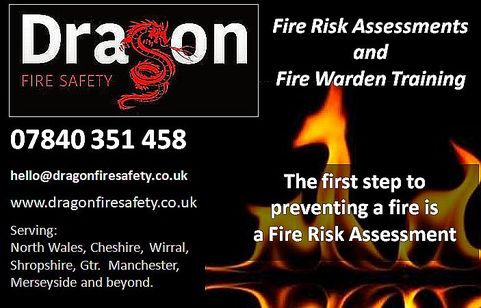07840 351 458 [email protected]
Dragon Fire Safety answers your questions about Fire Risk Assessments.
Q. Who is responsible for Fire Safety in a business?
A. According to the law, this is the “Responsible Person”. This can be the owner, employer or landlord, or all of them. The Responsible Person must:
Ensure that a Fire Risk Assessment is carried out.
Consider people who may be at particularly risk
Eliminate or reduce any Fire Risks as far as possible
Provide Fire precautions to deal with any remaining risk
Put in place any additional Fire Safety measures where flammable or explosive materials are stored
Create an emergency plan and document their findings
Review their findings as necessary.
Q. What is a Fire Risk Assessment?
A. A Fire Risk Assessment is a thorough and systematic evaluation of your place of work which will identify potential hazards and will determine the level of risks in your workplace, and how they can be adequately controlled.
Q. Can anyone carry out a Fire Risk Assessment?
A. NO! A Fire Risk Assessment should be completed by someone with sufficient training or experience in fire safety. A small company is unlikely to have someone with sufficient knowledge and expertise in-house and should therefore employ an external consultant to conduct a Fire Risk Assessment for them.
Q. What are the main points of a Fire Risk Assessment?
A. Fire Risk assessments can be broken down into the following points:
1. Indentify Fire Hazards
2. Indentify people at risk
3. Evaluate, reduce, remove and protect from risk
4. Record, plan, inform and train
5. Review and revise as needed.
Q. Is a Fire Risk Assessment a one-off process?
A. No. Fire Risk Assessments must be reviewed and amended regularly to meet any changes in circumstances, procedures or changes to the building. There is no specific time scale given but it is widely accepted that the Fire Risk Assessment should be reviewed every 12 months.
Q. How seriously should I take arson and can I prevent it in my work place?
A. Most serious fire risks to places of work are from deliberate arson attacks. Many building fires start from outside the premises and then spread inside. Do not stack or store combustible materials against outside walls or next to fences. Make sure waste material is stored securely and kept to a minimum.
Q. How do I manage Fire Safety correctly?
A. Unfortunately one of the main causes of fatalities from fire is the failure of occupants of the building (both staff and members of the public) to take appropriate action when fire is discovered or a fire alarm is raised. The most effective way to combat this is effective management alongside appropriate staff training.
Fire routines regarding different actives that take place must be drawn up. The responsible person should also ensure that all Fire Safety features are in working order and that no undue fire risks are apparent.
A vital part of any Responsible Person’s duties is the training of staff. All staff members, including part time, temporary, contractors and cleaning staff must be familiar with the actions to be taken in the event of a fire. They must also know how to call the fire services, any main fire prevention measures and where the exits and exit routes are.
Q. What Fire Safety Training does the law say I must give to my staff?
A. It is the responsibility of the company management to make sure that all staff have received adequate training on the actions to take in the event of a fire. Training should be given at time of induction to the workplace or ideally in the first month of employment. It is down to the discretion of the management as to how often refresher training should take place, however it should be given at least once a year.
Training should be undertaken by a competent person and a record should be kept. It can be carried out in many ways such as in-house, class room based course or distance learning course. In larger companies, individuals who are given greater responsibilities during an evacuation, such as Fire Wardens or Fire Marshals, must be given additional training.
Businesses must also test out their fire evacuation procedures at least once every 12 months by means of a fire drill.
Q. What steps do I need to take to protect disabled staff and members of the public?
A. The Responsible Person must take reasonable steps to change practices and procedures that may make it difficult for a disabled person to access facilities and services. For example, can wheelchair negotiate ramps? Are all doors and passages wide enough to allow passage of wheelchair?
It will have to be established whether they will require assistance in the event of an evacuation.
Q. How often should I test / service Fire Safety Equipment?
A. The testing and maintenance of fire precautions is a vital responsibility of management. Fire safety equipment has been installed for a reason, and there are serious legal obligations to make sure that all Fire Safety Equipment is maintained to a high working standard. Testing regimes are usually in accordance with British Standards (BS) for the particular equipment. It is also a legal requirement to keep an accurate record of these checks for inspection by enforcement agencies. This record is best kept in the form of a Fire Safety Log Book.
Do you have any other questions? Perhaps a specific fire safety question relating to your premises? If so, please do contact us on the contact form or by email. We do not charge for general advice, even if you are not one of our customers.

